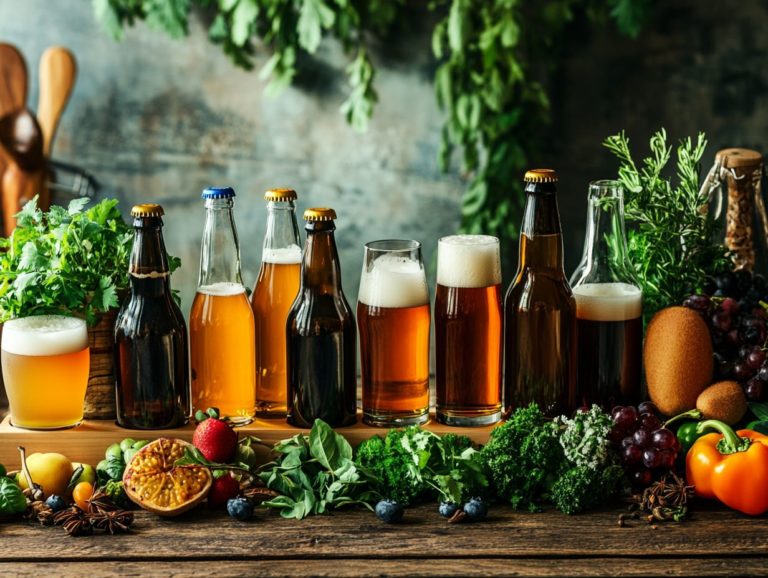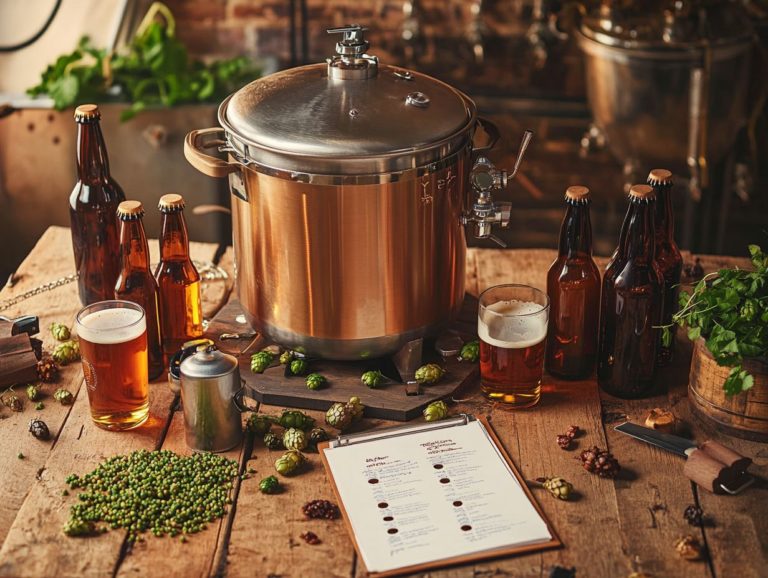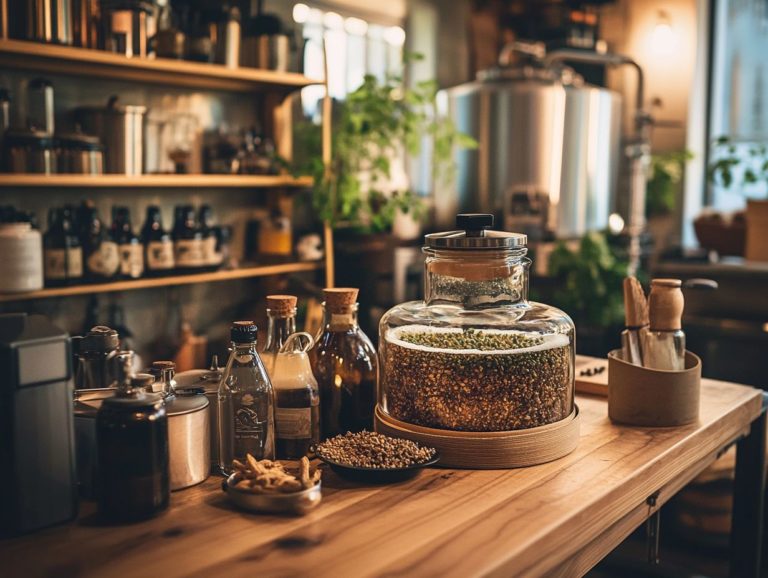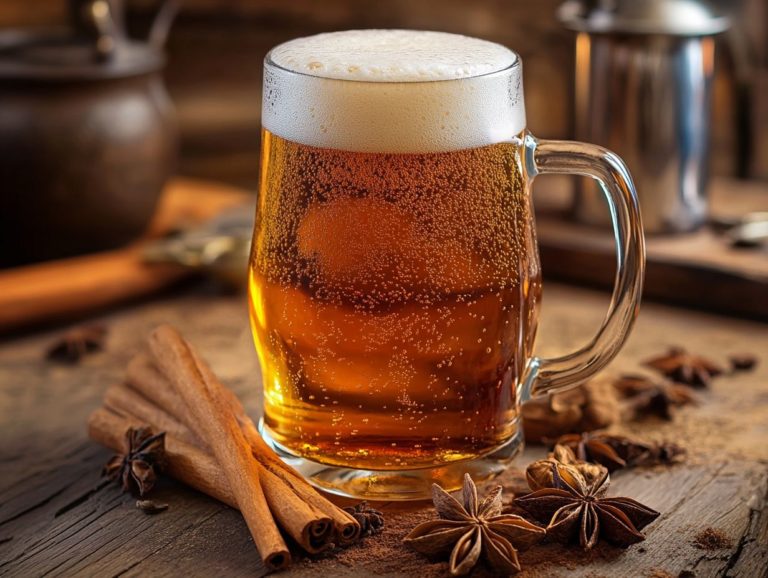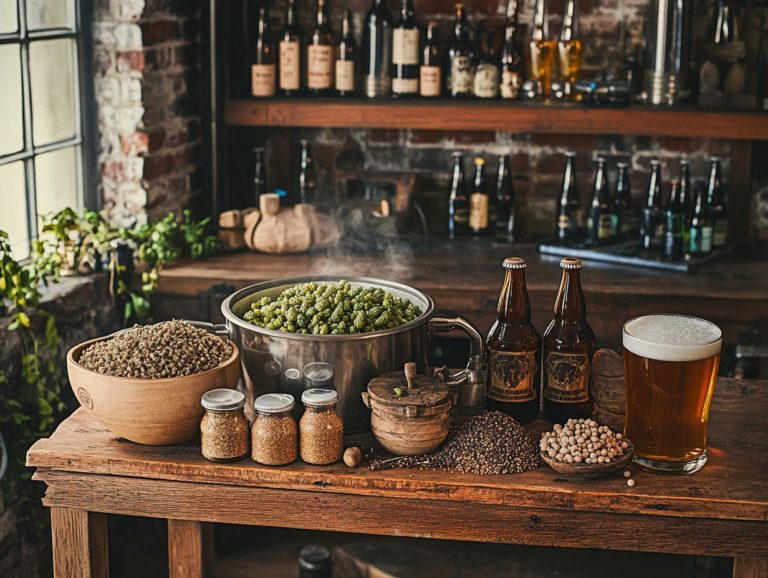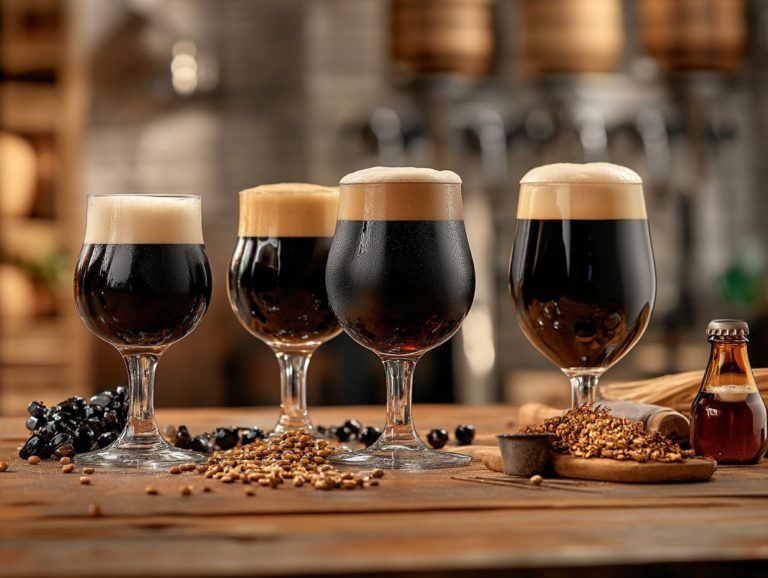10 Tips for Refining Your Beer Recipes
Creating the perfect beer recipe is an art form that marries tradition, creativity, and a splash of science, making use of various brewing techniques. Whether you’re a seasoned brewer or just beginning your journey, refining your recipes can elevate your craft to remarkable heights.
Here are ten expert tips to guide you in developing exceptional brews. From selecting a solid base recipe to experimenting with unique ingredients and techniques, these insights will empower you to create standout flavors and enhance your brewing process.
Here s to crafting your best beer yet!
Contents
- Key Takeaways:
- 1. Start with a Good Base Recipe
- 2. Experiment with Different Types of Malts
- 3. Play with Different Hop Combinations
- 4. Consider Adding Specialty Grains
- 5. Don’t Be Afraid to Add Fruit or Spices
- 6. Try Different Yeast Strains
- 7. Adjust Your Water Chemistry
- 8. Pay Attention to Fermentation Temperature
- 9. Age Your Beer Properly
- 10. Continuously Refine and Improve Your Recipe
- What Are the Key Elements of a Good Beer Recipe?
- What Are the Most Common Mistakes in Beer Recipe Development?
- How Can You Incorporate Local Ingredients into Your Beer Recipes?
- What Are Some Tips for Creating Unique and Standout Beer Recipes?
- How Can You Use Feedback from Others to Improve Your Beer Recipes?
- What Are Some Resources for Learning More About Beer Recipe Development?
- Frequently Asked Questions
- What are the top 10 tips for refining my beer recipes?
- How can I research and understand different beer styles?
- What is the importance of keeping detailed notes on each batch for your beer recipes?
- Why should I experiment with different hop varieties and hop additions?
- What are some common adjuncts used in beer recipes and recipe development?
- How can I utilize water chemistry in my beer recipes and brewing process?
- Why is it important to continuously refine my brewing process and techniques?
Key Takeaways:
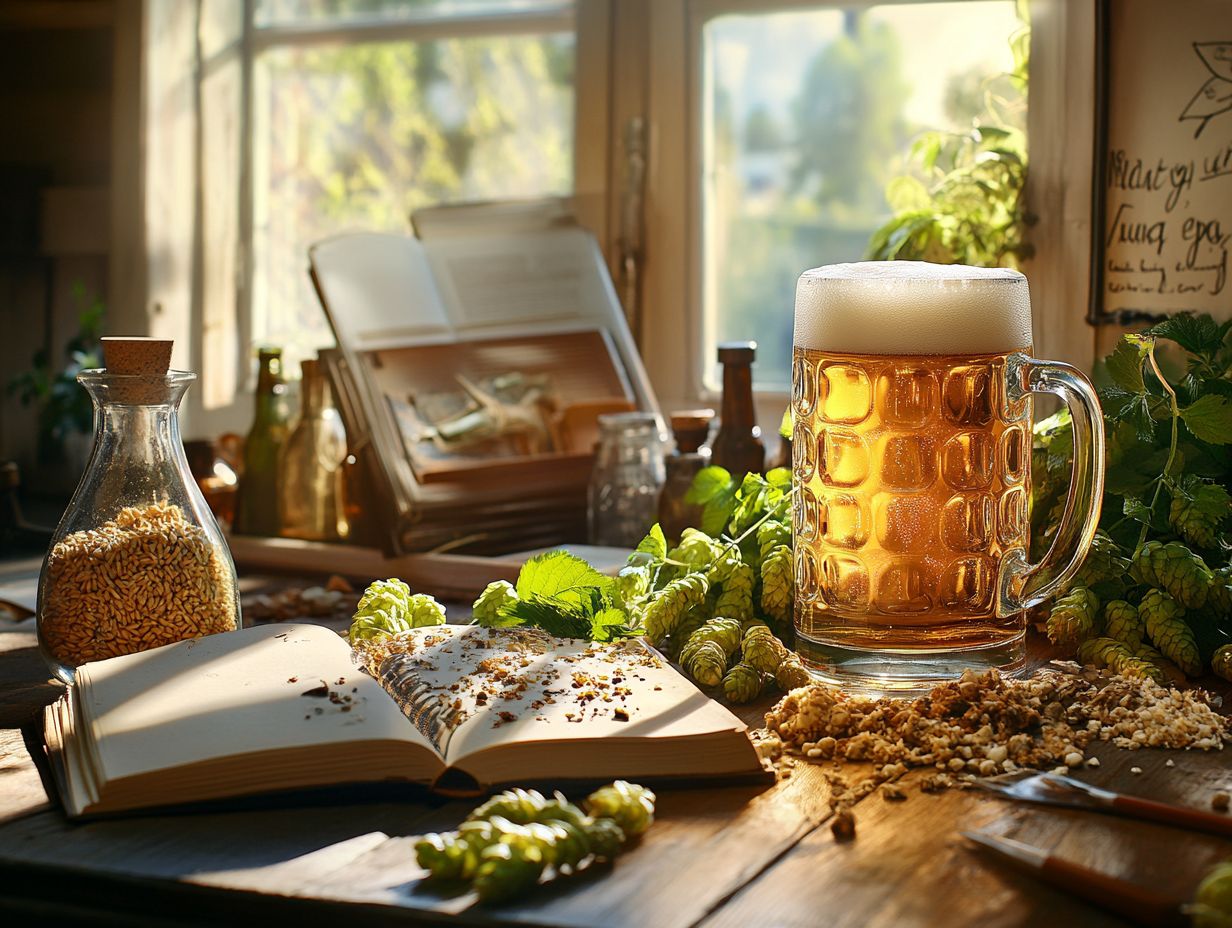
- Start with a solid base recipe it’s the foundation for great beer.
- Experiment with different malts, hops, and yeast to create unique flavors and aromas, while optimizing your hop utilization.
- Don t hesitate to add specialty grains, fruit, or spices for added complexity and depth, enhancing your beer recipes.
1. Start with a Good Base Recipe
Starting with a solid base recipe is essential for any brewer aspiring to scale up their craft beer production. It helps achieve consistent results in brewing endeavors. A thoughtfully crafted malt bill, paired with the right techniques, lays the groundwork for enhancing your beer’s overall flavor profile.
Utilizing brewing software enables you to manage variables like the sugar level before fermentation. This ensures your initial brews are not only successful but also align with your intended recipe development.
Choosing the right malt is pivotal, as it serves as the backbone of your beer, influencing flavor, color, and mouthfeel. Original gravity is crucial; it indicates the fermentable sugars transformed during fermentation. This directly affects the final alcohol content and body of your brew, which is vital for maintaining brewhouse efficiency.
Brewing software elevates your recipe development process by enabling you to experiment with various malts, calculate accurate measurements, and monitor fermentation progress. This support streamlines your efforts, helping you refine your recipes over time so each batch consistently meets your desired specifications. This innovation is particularly beneficial when scaling up to commercial brewing.
2. Experiment with Different Types of Malts
Dive into the world of malts! Experimenting with them can transform your beer’s flavor profile, allowing you to uncover unique characteristics that define your craft beer style. Each malt variety brings something special from the rich, caramel notes of crystal malts to the delightful biscuity undertones of Munich malt.
Opting for single malt options can add incredible depth. Different roast levels will influence both sweetness and bitterness. Embrace the joy of crafting recipes that harmonize these malty flavors; after all, creativity is essential in your brewing journey.
Be mindful to avoid common pitfalls, like overloading on crystal malts, which might lead to overwhelming sweetness. Also, don t overlook the fermentation process, as it can easily mask the intended malt character. Consider split batch brewing to experiment without compromising entire batches.
3. Play with Different Hop Combinations
Playing with different hop combinations can elevate your brewing techniques, enhancing hop utilization and introducing complex flavors to your craft beer. Exploring various hop varieties will expand your brewing repertoire.
By experimenting with different hop varieties and their unique flavor profiles, you gain access to a palette of aromas and tastes that will transform your brews into something extraordinary. Each hop type offers distinct characteristics ranging from floral and citrusy notes to earthy and spicy undertones. Your first brews with new hop varieties can set the stage for consistent recipes in the future.
Timing is everything in the brewing process; adding hops earlier in the boil enhances bitterness, while later additions boost aroma without increasing bitterness. Experimenting with the timing and quantities of these hops can lead to delightful discoveries in flavor, ensuring every batch of beer you create has its own unique personality.
Start brewing today and unleash your creativity!
4. Consider Adding Specialty Grains
Ready to elevate your brewing game? Incorporating specialty grains into your malt bill can elevate your beer to new heights, introducing flavors and complexities that distinguish it from the exciting world of craft beer.
These distinctive ingredients, like crystal malts, roasted barley, and specialty wheat, do more than enhance color; they impart caramel, chocolate, and nutty notes that can significantly transform the tasting experience. For example, when you brew a porter with chocolate malt, you achieve a rich, velvety mouthfeel. Adding caramel malt to a pale ale delivers a delightful sweetness that perfectly balances hop bitterness.
Dry yeast can also be combined with these grains for a versatile brewing process. Many brewers discover that experimenting with various specialty grains unlocks their creative potential, allowing them to craft innovative styles. Imagine a spiced brown ale that harmonizes the warm flavors of biscuit malt with seasonal spices, inviting drinkers to savor the intricate layers in each sip.
5. Don’t Be Afraid to Add Fruit or Spices
Don’t hold back! Adding fruit or spices can elevate a standard recipe into a distinctive beer style, giving you the power to explore new flavor profiles and craft unforgettable beer experiences that will amaze your friends!
Consider the delightful pairing of citrus fruits like oranges or lemons with spicy notes such as coriander; this combination can transform a wheat beer into a refreshing and zesty masterpiece.
To effectively incorporate these ingredients, it s best to add the fruit during the fermentation process, allowing the yeast to interact with the sugars. Meanwhile, spices can be introduced during the boil or at packaging, depending on the intensity you wish to achieve. By carefully measuring and timing your additions, you can create a balanced flavor that is both inviting and refreshing.
6. Try Different Yeast Strains
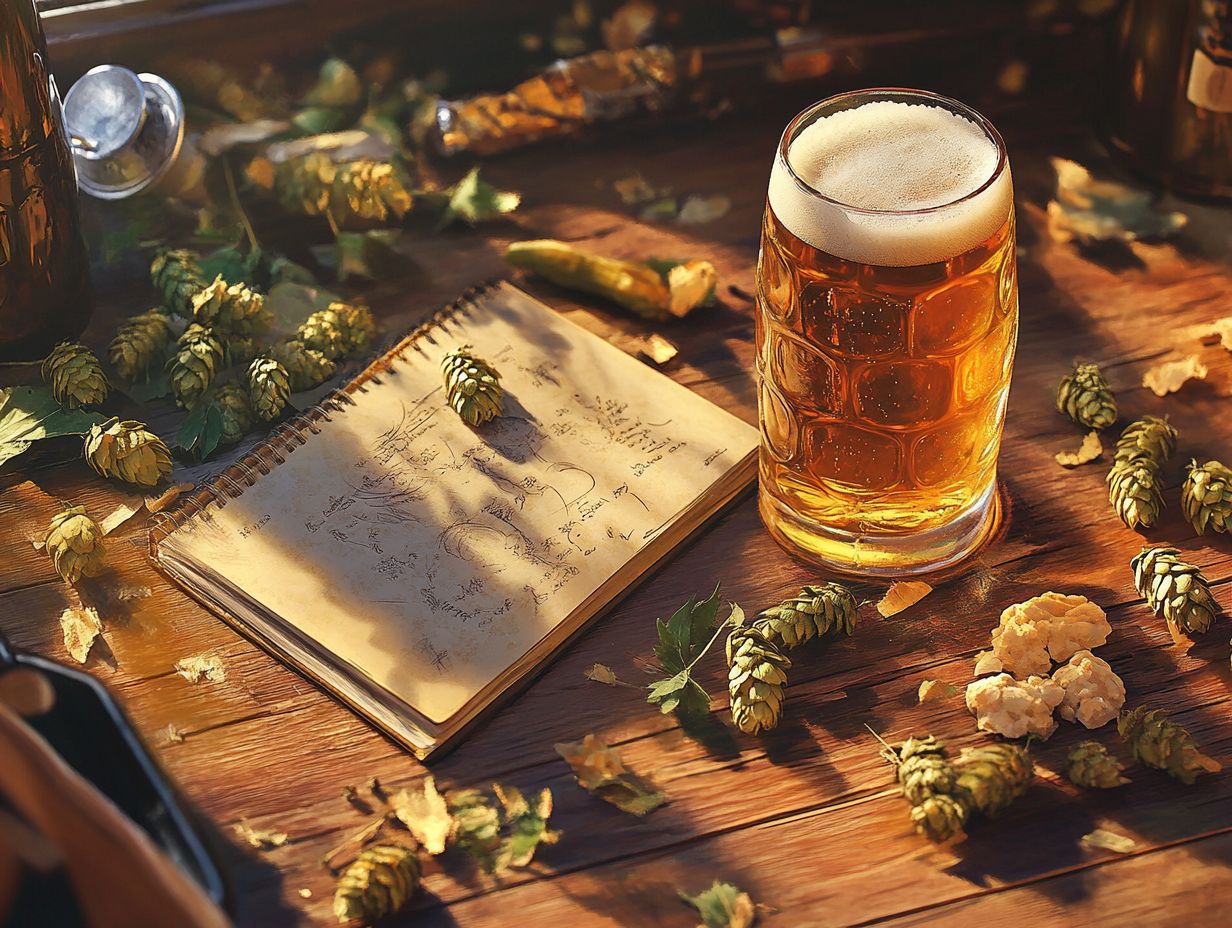
Exploring different yeast strains can significantly influence your fermentation process, shaping both the flavor profile and mouthfeel of your craft beer. Each yeast strain brings its own set of flavors from fruity esters to spicy phenols that can elevate a simple brew into something truly exceptional.
Understanding the fermentation process is essential, as yeast not only converts sugars into alcohol but also plays a pivotal role in developing the beer’s aroma and taste. Choosing the right yeast for specific beer styles is crucial; for example, ale yeasts tend to perform best at warmer temperatures, imparting bolder flavors, while lager yeasts flourish in cooler conditions, resulting in cleaner, crisper profiles.
By thoughtfully considering these factors, you can craft beers that are not only rich in flavor but also true to their intended style. Experimenting with dry yeast offers more control over fermentation.
7. Adjust Your Water Chemistry
Don t underestimate the power of water chemistry in brewing! Adjusting your water chemistry is a crucial element of the brewing process that can significantly enhance your brewing efficiency and directly influence the flavor profile of your final product. The water you use can make or break the outcome of your beer recipes.
Understanding the intricate balance of components such as pH levels (the measure of acidity in the water) and mineral content is essential for you as a brewer, especially when striving to achieve your desired outcomes. pH plays a pivotal role in the enzymatic activities (the processes that help convert grains into sugars) during the mash, impacting sugar extraction, while minerals like calcium, magnesium, and sulfate can elevate specific flavors and aromas in your finished beer.
For example, a higher sulfate content might be just what you need for IPAs, enhancing that delightful hop bitterness, whereas a balance tilted towards chloride can provide a smooth mouthfeel ideal for stouts and porters.
Practical adjustments like using gypsum for a dry finish or calcium chloride for added richness enable you to tailor your water profiles to suit various beer styles, transforming every batch into a canvas for your creativity. This is where brewing software can be especially advantageous.
8. Pay Attention to Fermentation Temperature
Maintaining the right fermentation temperature is essential for effective yeast management, as even slight variations can lead to off-flavors and significantly impact the overall character of your craft beer. Consistent temperature control is vital for every brewing system.
Different yeast strains flourish within specific temperature ranges. Ales typically thrive between 65 F and 75 F, while lagers prefer cooler conditions, hovering around 45 F to 55 F.
When fermentation temperatures drift outside these ideal ranges, yeast activity can become stressed. This stress produces undesirable byproducts that can compromise the flavor profile of your brew.
To achieve consistency, it’s vital to monitor fermentation conditions meticulously. Employing temperature control systems such as fermentation jackets or temperature-regulating water baths can help you mitigate unwanted fluctuations, providing a more stable environment for your yeast. By keeping a vigilant eye on thermometer readings and making adjustments as necessary, you can elevate the quality of your final brew to new heights. Proper yeast handling and temperature control can also enhance commercial brewing operations.
9. Age Your Beer Properly
Aging your beer properly can truly elevate the flavor profile, allowing those complex tastes to develop and mellow into a much more enjoyable craft beer experience. This is crucial for refining your recipes over time.
This process is not just about hiding your beer away; it’s an art that requires thoughtful attention to timeframes and environmental factors, including temperature and light exposure. Certain styles thrive on this slow transformation take barrel-aged stouts, for instance. They develop rich notes of chocolate and vanilla after months of resting, turning into something truly special.
It’s also important to understand the original gravity, which measures the sugar content before fermentation, and how it influences the aging process.
Belgian ales and sour beers undergo a remarkable metamorphosis, with their sharp edges softening over time, resulting in beautifully fragrant brews with layered notes. Meanwhile, pale ales are best savored fresh, preserving their hoppy brightness. Each beer style has its own ideal aging conditions.
This clearly illustrates that timing is vital in the aging process, ensuring that each sip you take is exactly as it should be. Fine-tuning your brewing system can also help you control these variables more effectively.
10. Continuously Refine and Improve Your Recipe
Continuously refining and improving your beer recipes is paramount for maintaining the innovation of your craft beer while aligning with your brewing aspirations and the preferences of your audience. Leveraging brewing software can streamline this process, providing precise control over each batch.
This journey heavily relies on the feedback you gather from tastings and market responses, offering you invaluable insights into what truly resonates with drinkers. Don’t wait too long to gather feedback understand what your audience loves now!
Understanding how different brewing techniques influence the final product gives you the power to experiment and iterate thoughtfully. This is particularly important if you’re considering commercial brewing.
By assessing the unique flavor profiles that emerge from these adjustments, you can craft distinctive brews that capture attention in a crowded market. Trying a split batch approach can help you compare different variations side-by-side.
Embracing this iterative approach not only enhances the quality of your beer but also fosters a deeper connection with your community, ultimately guiding your future innovations in recipe development.
In conclusion, paying attention to fermentation temperature, aging your beer properly, and continuously refining your recipes are essential tips for brewing great beers that can significantly improve your brewing process and the quality of your craft beer.
What Are the Key Elements of a Good Beer Recipe?
Crafting an exceptional beer recipe requires a careful balance of several key elements, including the careful selection of ingredients like malt, hops, yeast, and water, alongside the brewing techniques that create a harmonious flavor profile appealing to discerning beer enthusiasts.
Each ingredient you choose plays a pivotal role in the final outcome. Take malt, for instance; it not only provides the sugars necessary for fermentation but also contributes significantly to the beer’s color and body.
Hops, in contrast, introduce bitterness and aroma, effectively balancing the sweetness contributed by the malt. Yeast is another crucial player, as it transforms sugars into alcohol while generating unique esters and phenols that elevate the overall character of your brew.
Don’t underestimate the importance of water quality either, as its mineral content can profoundly influence both taste and mouthfeel. The brewing technique you employ, whether it involves precise temperature control during mashing or the strategic timing of hop additions, greatly affects the resulting beer style. To enhance your home brewing experience, consider these 8 tips for brewing great beer at home. This highlights the intricate interplay between these components, which ultimately defines the distinctiveness of each brew you create.
What Are the Most Common Mistakes in Beer Recipe Development?
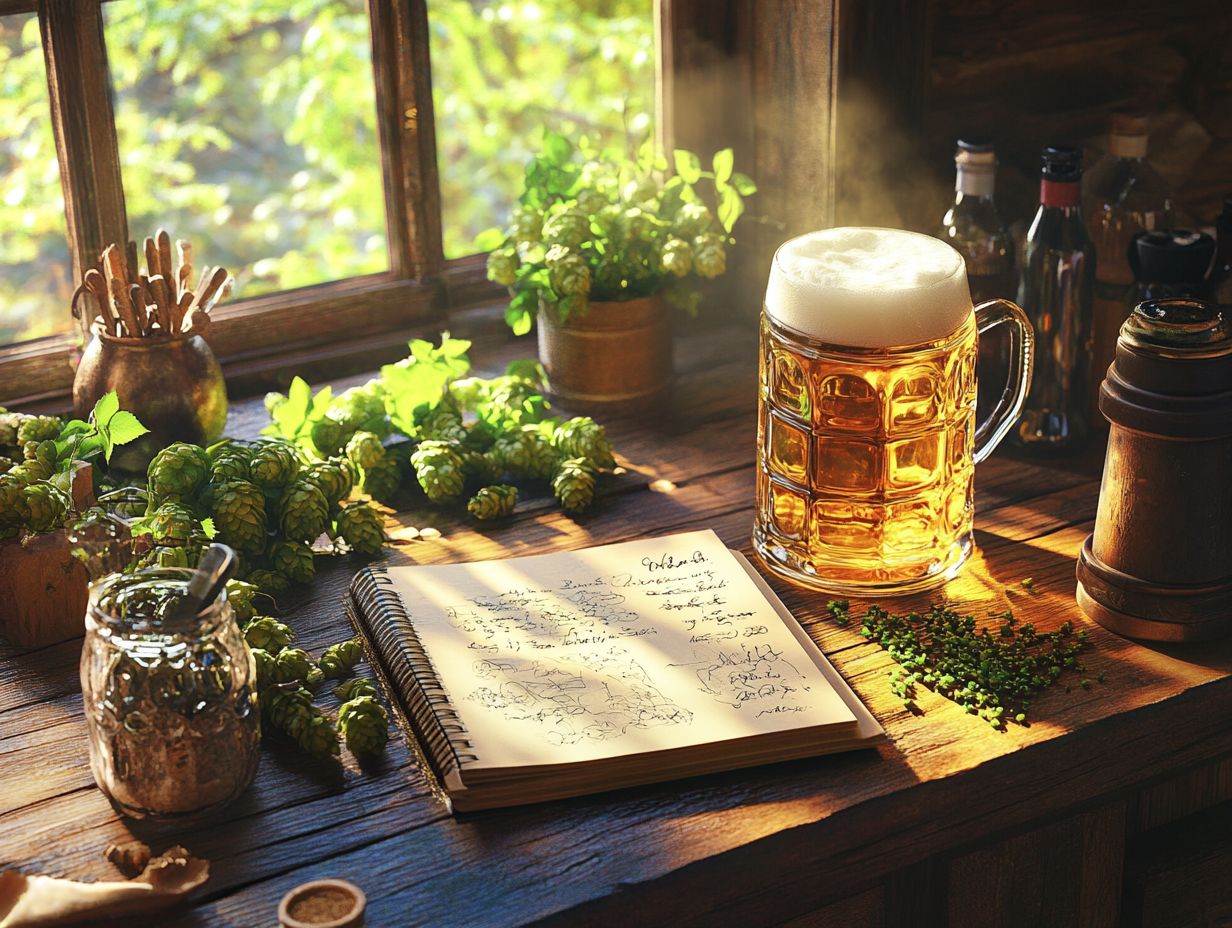
In your journey of beer recipe development, it s crucial to steer clear of common mistakes that can drastically affect the final product. Miscalculating ingredient ratios and overlooking the importance of fermentation temperature can significantly alter the overall flavor profile. These pitfalls often arise from insufficient preparation or a limited grasp of the brewing process.
One of the most prevalent errors comes from poor yeast handling. If you’re not ensuring the proper amount of yeast used or providing adequate oxygenation, you may find yourself facing stalled fermentation or undesirable off-flavors. Ineffective hop utilization whether due to improper timing during the brewing process or subpar storage methods can compromise the intended bitterness and aroma of your brew.
To navigate these challenges successfully, you should prioritize thorough research, embrace the art of experimentation, and, perhaps most importantly, learn from your past experiences. Gaining a solid understanding of the specific needs of yeast and hops can make a world of difference, leading you to a brewing adventure enriched with vibrant flavors and consistent results. For beginners, following 10 essential home brewing tips is also crucial, as it can significantly impact the quality of your final product.
How Can You Incorporate Local Ingredients into Your Beer Recipes?
Incorporating local ingredients into your beer recipes not only supports regional agriculture but also allows you to craft unique flavors that truly reflect the terroir (the unique characteristics of a specific region) of your area.
The advantages go well beyond just taste; when you utilize seasonal produce and native grains, you enhance the freshness, sustainability, and creativity in your brewing process. Imagine brewing a pale ale with locally sourced hops that bursts with vibrant citrus notes, capturing the essence of the local sunshine. Or consider a stout made with native grains that brings a rich, nutty undertone, showcasing the agricultural heritage of your region.
This approach not only elevates your beer s flavor profile but also fosters a deeper connection between you and your local producers, promoting a sense of community and appreciation for the resources that surround you. Using native grains and seasonal produce can add unique elements to your recipes.
So why not dive into your local market and discover unique flavors to inspire your next brew? Local ingredients await your creativity!
What Are Some Tips for Creating Unique and Standout Beer Recipes?
Creating unique and standout beer recipes demands a perfect blend of creativity and technical know-how. Explore exciting brewing techniques and a diverse array of ingredients to craft an exceptional flavor profile.
To truly push the boundaries of traditional brewing, embracing the spirit of experimentation is essential. This might involve incorporating unexpected elements like exotic fruits or herbs or even exploring alternative fermentation methods, such as spontaneous fermentation with wild yeast. A single malt approach can also provide a unique base for your experimental brews.
For instance, think about brewers who opt for barrels that once held spirits. This infuses their beers with complex flavors that challenge conventional styles. A striking example is a sour ale aged in tequila barrels, which introduces bright citrus notes alongside a refreshing tartness. This showcases how breaking the mold can lead to intriguing new tastes and memorable experiences.
How Can You Use Feedback from Others to Improve Your Beer Recipes?
Using feedback from others is an invaluable tool for brewers seeking to enhance their beer recipes. Constructive criticism can provide insights into how well your flavor profiles resonate with various palates.
Engaging in tastings allows you to capture immediate reactions while fostering a sense of community. This strengthens the connection between you and your consumers. Participating in beer competitions can further refine this process, offering structured feedback from judges with extensive experience. This feedback loop is invaluable for recipe development.
Leverage social media platforms for community engagement. This opens up new avenues for gathering diverse opinions. By carefully assessing feedback and analyzing common themes, you can strategically adapt your recipes. This iterative process elevates the quality of your beer and nurtures a loyal customer base that feels valued and heard.
What Are Some Resources for Learning More About Beer Recipe Development?
You ll find a wealth of resources at your fingertips if you re eager to dive deeper into beer recipe development. From insightful brewing books, comprehensive online courses, to hands-on workshops and vibrant community brewing groups, each avenue can significantly amplify your brewing techniques and knowledge.
Respected texts like “The Complete Joy of Homebrewing” and “How to Brew” lay a solid foundation, revealing the intricate science and art behind brewing. Online platforms such as CraftBeer.com and the Brewers Association’s website are treasure troves of information, filled with articles, guidelines, and the latest industry news to keep you informed. Additionally, brewing software can provide a more hands-on learning experience.
Engaging with communities on forums like Reddit or joining local brewing clubs offers invaluable opportunities for peer-to-peer learning. Continuous learning elevates your brewing skills and ensures you stay updated on the latest trends and innovations within the craft beer industry. Understanding how to manage your malt bill effectively can also significantly improve your brewing process.
Frequently Asked Questions
What are the top 10 tips for refining my beer recipes?
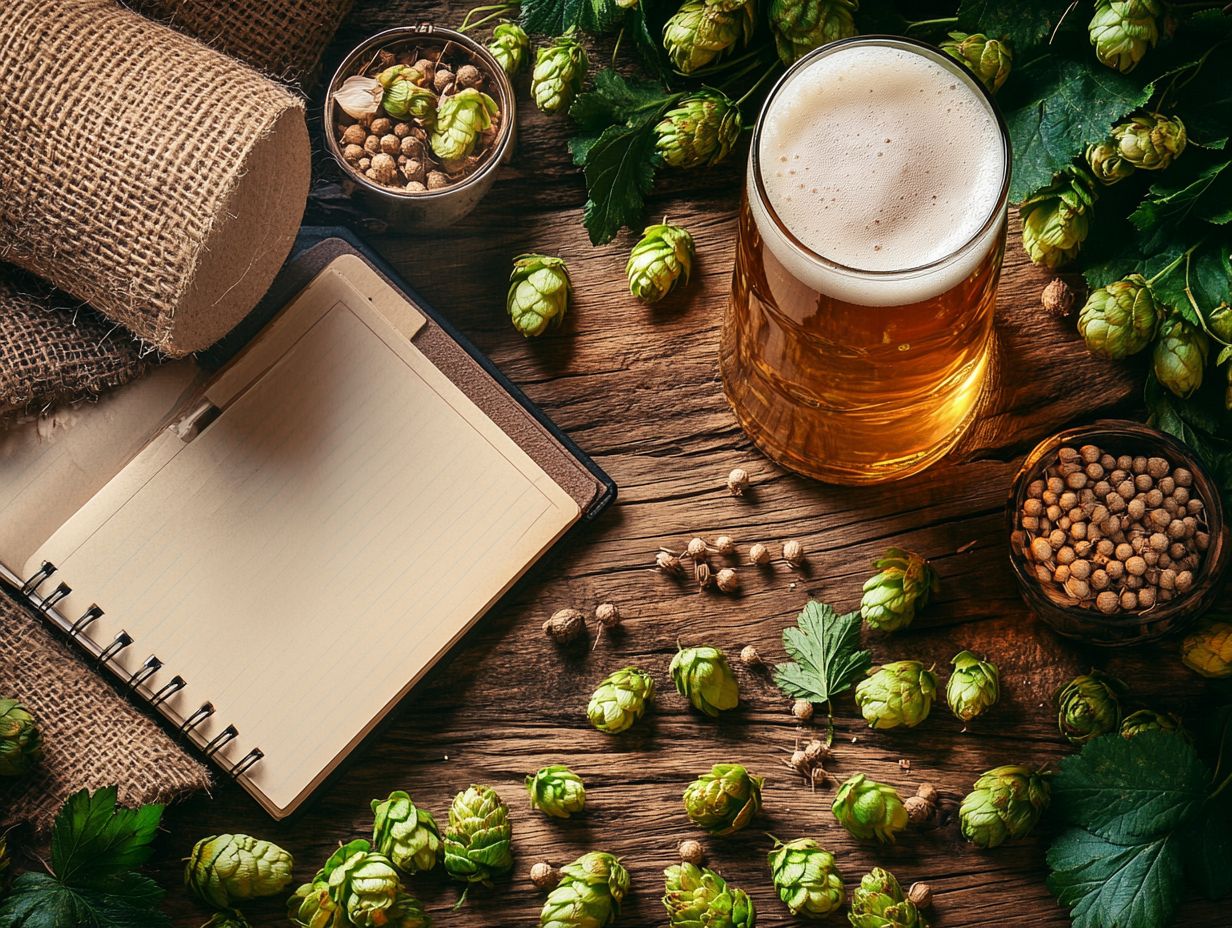
- Research and understand different beer styles to guide your recipe development. Studying your first brews provides a good foundation for future improvements.
- Pay attention to ingredient quality and freshness.
- Keep detailed notes on each batch to track what works and what doesn’t.
- Experiment with different hop varieties to find the perfect balance.
- Consider adding adjuncts, such as additional ingredients like fruits or spices, for added complexity.
- Use water chemistry to enhance flavor and mouthfeel.
- Don’t be afraid to adjust your recipe based on feedback from others.
- Practice proper sanitation techniques to avoid off-flavors.
- Utilize yeast starters to ensure a healthy and active fermentation.
- Continuously fine-tune your process and techniques for optimal results.
How can I research and understand different beer styles?
To understand beer styles, explore their unique flavors and brewing methods. Historical context also plays a role.
Use books, online articles, brewing software, and beer competitions to gather insights. Joining a homebrew club or attending brewery tours provides firsthand experience with various beer styles and techniques.
What is the importance of keeping detailed notes on each batch for your beer recipes?
Keeping detailed notes on ingredients and processes helps you identify patterns. This practice is essential for replicating successes and troubleshooting issues.
Recording specifics such as ingredient measurements, mash temperatures, and fermentation timelines is crucial for maintaining brewhouse efficiency.
Why should I experiment with different hop varieties and hop additions?
Hops shape the bitterness and aroma of your beer. Experimenting with different varieties will help you craft unique flavors.
Finding the perfect balance affects hop utilization and overall flavor development in your recipes.
What are some common adjuncts used in beer recipes and recipe development?
Common adjuncts include fruits, spices, coffee, and chocolate. These additions enhance complexity and depth in your brews.
Experimenting with adjuncts is an important part of recipe development and elevating your flavor profile.
How can I utilize water chemistry in my beer recipes and brewing process?
Water’s mineral content and pH affect beer flavor and mouthfeel. Adjust these to enhance characteristics or mimic desired styles.
Understanding water chemistry is vital for optimizing your brewing system and process.
Why is it important to continuously refine my brewing process and techniques?
Brewing is an exciting journey! Embrace continuous learning to elevate your craft. Refining your brewing skills is key to achieving consistent results.
As you improve, discover new ingredients and commercial brewing methods to incorporate into your recipes.

